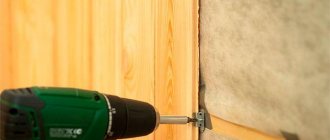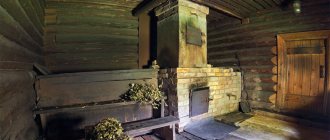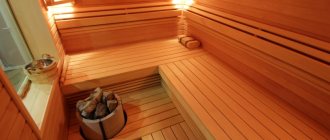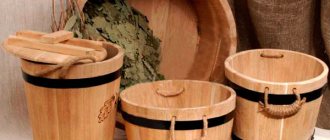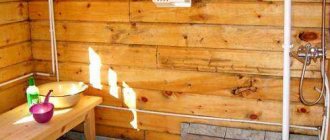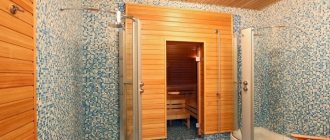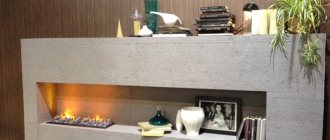When starting any construction, you should understand each stage in detail.
It would seem that if you miss the smallest detail, it will not affect the final result. However, this assumption is completely incorrect. In this article we will dwell in detail on the example of such a structure as a bathhouse. As a rule, a bathhouse is built somewhere on a country site. For rural areas (villages) this is a common thing. But even today, those who prefer to live in their private home are thinking about building a bathhouse. After all, it serves not only to make it possible, say, to organize park days once a week. A modern bathhouse is primarily a place of relaxation, including a room equipped with a table and comfortable seats. If desired, means of watching television programs, listening to music, etc. can be connected.
Regardless of which option you choose, there are a number of requirements that apply to any of them. In order to preserve the wood structure from the effects of moisture, fungi and other negative factors, special wood impregnations for baths should be used. Previously, little thought was given to such things. This is due to the fact that in the old days there was simply nothing like this. Later, access to such materials in villages was very limited. The situation was solved by using coniferous wood in construction, which is naturally impregnated with resins that protect against environmental influences.
However, progress does not stand still. The use of new means of protection is common and necessary today. You need to decide what wood impregnation is. In general terms, it is a liquid of a certain chemical composition (solvents, film formers, various additives, dyes, tints, etc.). You should clearly understand which product you need based on your specific needs. In relation to the bathhouse, the issue of using compositions with fire-resistant and moisture-resistant properties will be relevant. There are compositions that combine several properties (protection from fungus, rot, fire). In my opinion, the use of such a composition is optimal.
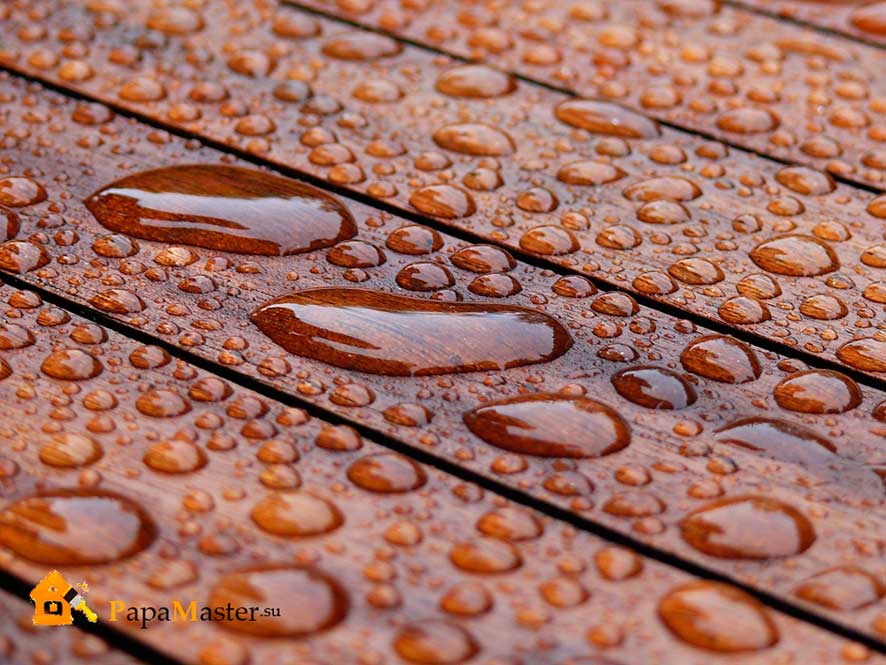
Impregnation for wood for a bath can also be presented in a more traditional form, namely: varnishes, drying oils, waxes, stains and others. They also protect the surface quite well from negative influences.
I would like to draw your attention to the fact that first of all you should think about the competent design of the bathhouse, stove, ventilation, etc.! With good design and execution of construction work, the tree will require minimal processing agents!
You need to know about this!
There are many facts that are interesting and educational. For example, Finns are big fans of saunas. In this state, 2 million saunas have been built for every 5 million people. This is simply amazing! Even in a multi-storey building, where it would seem impractical to build a bathhouse, it is still installed in the area of the ground floor or in the basement.
Residents of Finland love their country, as well as its ecology. They put human health in the foreground, because in the sauna you can improve your health and strengthen your body as a whole. The Finns treat sauna premises with care; they have long used all kinds of chemicals, and the Russians have learned a lot from them, having adopted the experience of caring for wooden structures.
What preparations can be used when treating a bath?
Before starting a conversation about chemicals, you need to understand in more detail the properties and characteristics of wood, which is most often used as a building material for a bathhouse. Moreover, there are many types of wood that are in demand in this construction sector. Most often when creating wooden structures they use:
- Pine and spruce.
- Larch and juniper.
- Aspen and hornbeam.
- Birch and alder.
- Beech and oak.
- Elm and cherry.
- Pear and maple.
- Linden and ash.
First of all, the choice of wood will depend on the place of residence of a person. The bathhouse itself is built from coniferous trees, since they have a dense structure, absorb less moisture, and the structure lasts longer. As for hardwoods, preference is given to oak and aspen.
If you decide to start processing a bath structure, you first need to find out what properties the wood of certain types of wood has, only in this case the questions can be successfully resolved: how to treat the bathhouse inside and out? the best chemistry ?
Tips for choosing antiseptics
When choosing products for treating a wooden floor in a bathhouse, you need to know what properties they should have:
- Water-repellent properties, since water creates favorable conditions for the development of pathogens. To prevent them from appearing, it is necessary to ensure that the wooden panels of the room are dry. Impregnation provides a protective layer that prevents moisture from penetrating the flooring.
- Repellent substances, since the tree is susceptible to damage by rodents and insects. So, impregnation containing a repellent component will prevent pests from infesting, ensuring the safety of the floor covering.
- The impregnation must contain antiseptic elements (phytoncides), which are destructive to mold and mildew.
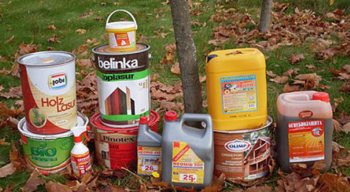
Types of impregnations
What is wood?
Wood is classified as a natural building material that has specific properties:
- Speaking about mechanical properties, it is assumed that wood is a strong and solid material that is almost not deformed. It has excellent operational and technological qualities; this building material is able to withstand heavy loads.
- Physical properties are understood as the external data of wood (texture, color), its thermal conductivity, sound and electrical conductivity, and humidity.
- If we talk about chemical properties, it should be noted that this is a natural anisotrope, since differently oriented fibers have their own special characteristics. For example, when drying, fibers behave differently: longitudinal fibers take much longer to dry than transverse fibers. Radial fibers, in turn, dry faster than tangential fibers.
You should carefully consider the features of this building material in order to make the right choice of special protective compounds for wooden buildings and products:
- The strength of wood is the most important characteristic of the material. Thanks to it, it has the ability to resist various aggressive mechanical loads.
- To determine the hardness of wood, special tests are used, in particular the Janka test. In simpler terms, this is the degree of resistance of wood to the effects of bodies much harder than itself.
- The wear resistance of wood refers to the ability of the material and structures made from it to resist various impacts associated with operation.
- As for humidity, it can be absolute or relative.
Therefore, to decide how to treat the bathhouse inside and outside? better chemistry specifically designed for this purpose. But first you need to understand the characteristics of wood. If we talk about the operational parameters of this building material, they have a lot in common with properties, but may differ slightly in their purpose:
- Hardness and stability.
- Level of oxidation and resistance to mechanical stress.
Tree species from which various products are made, each of them has its own special physical, mechanical and chemical properties, as well as performance indicators. Naturally, the means for processing and impregnation cannot be the same. Although there are compositions that can be used for any breed. Thus, the question of funds practically disappears.
Impregnation for Pinotex wood
Today, there are a huge number of products that, according to manufacturers, are excellent for protecting wood. From personal experience I will say that one way or another, almost all products of this kind get the job done. However, their durability varies. One impregnation retains its properties for a couple of years, the other for 5 or more. This is where the true quality of the product is revealed. One of the leaders on the market is Pinotex wood impregnation. For its production, only the latest modern technologies developed at the research center of the Dutch company AkzoNobel are used. The company is a leader in the production of paint coatings and various types of wood chemicals. The company's work has spread to more than 80 countries, and its products are known in almost every corner of the world. In our country, Pinotex products are gaining increasing popularity.
Pinotex wood impregnation is available in a wide range, which includes a different palette and properties. Taking into account the needs of an individual consumer, anyone can choose the right product for themselves. As for cost, Pinotex products are an excellent choice in the price-quality segment.
Thus, to summarize, we can confidently say about the need to use wood impregnation. However, it is necessary to use it specifically for a bath carefully. I consider myself to be a supporter of those who say that wood in a steam room should breathe. Therefore, I do not offer advice on the large-scale use of treatment compounds in this part of the room. Proper ventilation and design of the bathhouse, natural waxes and oils, as well as your careful care of the wood - that’s all you need for a comfortable stay. For other rooms, as well as wooden buildings, I consider it advisable to use impregnations. If this is not done, then after some time the surface will lose its attractive appearance, will rot, and become covered with fungus. And this, in turn, will inevitably lead to the need to change entire links in the construction, which is very labor-intensive and expensive. The final choice is always yours.
What impregnation should be used to treat internal and external surfaces?
In a bathhouse, like structures made of wood, all surfaces made of this material must be treated. This also applies to walls, floors, and shelves. Since the sauna room is always too humid and there are sudden temperature changes, the wood must be protected: in the sauna, due to excess moisture, fungus, mold, bacteria and other harmful microorganisms and insects can develop. In addition, wood is a highly flammable material.
To properly treat and disinfect the external and internal elements of your bathhouse, use specially created preparations produced by the chemical industry that can save wooden buildings from possible complications. Here is the answer to the burning question, how to treat the bathhouse inside and outside? The best chemicals for treatment are antiseptics.
There are many impregnations for high-quality processing of wooden structures:
- Protecting from fire.
- From biological pests.
- Antiseptic.
- Whitening.
In addition, there are special preparations produced specifically for use in baths and saunas that contain natural oil with the antiseptic GOODHIM S200.
Even today they cannot do without wood, the oldest building material, despite the availability of modern options. The fact is that this is a unique material from which any building can be built, since it is natural, environmentally friendly, and has a lot of obvious advantages. And there is nothing better for building a bathhouse. The fact is that thanks to wood, a surprisingly healthy microclimate is created in the bathhouse. In hot weather, wooden buildings remain cool; in winter, they maintain above-zero temperatures for a long time.
There are also some disadvantages that are inherent in natural materials:
- Under the influence of natural disasters, wood can be destroyed.
- Due to the climate and operation, changes in external signs may occur.
- Mold, fungus, microorganisms living in wood, and insects have a negative effect on wooden structures.
- The material is highly flammable and burns quickly and hotly.
Today there are many new developments of chemical compounds that are being produced that can properly protect wooden buildings from fire, as well as from other disadvantages.
How to treat a bathhouse inside and outside? The best chemistry is, what exactly are the products? These questions have haunted more than one generation of washroom owners who care about the durability of their wooden structures. How to properly use the latest materials for sauna disinfection? One of these products is the detergent GOODHIM T150. To avoid mistakes and disappointment in the treatment of your bath, do not forget to take the time to study the recommendations indicated on the product:
- The product must be diluted in the specified proportions.
- Pre-prepare surfaces for treatment by removing all contaminants. Apply only after drying and degreasing.
- Apply chemical products only with a roller, brush, or brush. More than one layer will be required. In places where there was damage (fungus, mold), additional treatment will be required.
- Treat surfaces on which beetles live with GOODHIM STOPBUG.
- When working with an antiseptic, do not forget about the temperature not lower than plus five degrees and the corresponding humidity - 75 percent.
When choosing products for internal and external bath treatment, pay attention to what range can be provided for you:
- Detergents GOODHIM T150
- Oil protecting the shelves.
- Antiseptic GOODHIM S200.
Impregnation in the steam room and washing room. Personal opinion
The impregnation is selected taking into account the place of application (steam room, washing room, rest room, etc.). Most steam lovers will argue that there is no need to use chemicals in a steam room. The main argument is that the bathhouse must be healthy, and, as you know, at high temperatures, evaporation from the applied substance cannot be ruled out. In this case it is difficult to disagree. However, with prolonged use, wood exposed to humidity and temperature will certainly begin to lose its attractiveness. If you don’t care much about this, and you are ready to cover your favorite steam room with a new layer of lining every 2-5 years, then do not use any impregnation in the steam room.
I would recommend treating the steam room with natural waxes or oils. Canadian wax has proven itself quite well. The washing room and dressing room can be treated with special compounds for saunas and baths. There is a large selection of manufacturers: Tikkurila, Belinka, Eurotex, etc. The most problematic areas are backing boards, wooden ventilation ducts, floor joists, floor boards in the washing room and steam room, openings, slopes, crown, inter-crown seals and grooves. Before purchasing, you should pay attention to the composition. Some chemicals found in hand sanitizers can be harmful to pets. Therefore, carefully read the instructions and use personal protective equipment when applying.
The bathhouse can be washed with special products
How to treat a bathhouse inside and outside? The best chemistry is GOODHIM T150. This detergent has an excellent composition with which you can disinfect and destroy plaque formed by salts and lime. This product can be used to wash not only wooden structures, but also tiles, ceramics, glass, and metal.
The antiseptic wash has a pleasant aroma of pine needles, it is noteworthy that after treatment there are no stains left - cleanliness and shine! In addition, after treatment with this drug, fungus, mold, bacteria and microorganisms practically do not survive and do not appear for a long time.
Using this product you can whiten shelves; dilute a fairly concentrated composition with water in equal quantities. Apply with a roller, after a quarter of an hour you can wash off with clean water. This time is necessary for the product to be absorbed into the structure of the tree and disinfect it.
There is no chlorine in this product. Under no circumstances should it be used with formulations that contain this substance. If you are serious about choosing a bath treatment product, you can choose this particular product.
What oil can protect shelves in a bathhouse?
Impregnations intended for baths contain natural oils. You can only use them to protect wooden structures and products installed in the bathhouse. The oil is completely harmless, a person can calmly sit on benches, shelves and supports treated with the composition.
Antiseptic properties of impregnation oils:
- Does not allow fungus, mold, or harmful microorganisms to multiply.
- Dampness and any contaminants practically do not penetrate into the wood and are repelled from it.
Wood and buildings made from it will last much longer. Since these impregnations contain no toxic substances, a person can safely wash in a treated bathhouse. The treated surfaces are colorless and silky to the touch. Wood breathes because the pores remain free. Bathrooms and saunas welcome visitors with an excellent microclimate.
How to treat a bathhouse inside and outside? The best chemistry is impregnation, which should be applied to previously prepared and cleaned wood at a temperature below five degrees. Having completed the protective procedures, the bathhouse is heated. After this, it is cooled and ventilated. Be sure to remove any oil that is not absorbed. For this procedure, it is better to use a cellulose sponge or a soft, non-scratching piece of natural fabric. Owners of baths or saunas can use them for their intended purpose within a day.
This product is very economical: from 50 to 120 grams are required per square.
Antiseptic GOODHIM S200
Using this antiseptic, you can treat all structures and products in bathhouses and saunas made of wood indoors. It will protect surfaces and prevent them from collapsing. High air humidity, sudden temperature changes, fungal and mold formations will not harm the tree. Insects and microorganisms will not be able to settle in the treated wood.
The bactericidal property of GOODHIM S200 has long been noticed by users and is actively used to disinfect the bath room: there is no room for infections in it.
What benefits does this antiseptic bring:
- Having purchased this drug, you can immediately start working, since it is completely ready.
- Physical characteristics do not deteriorate.
- Thanks to the deep penetration of the impregnation, it is able to protect the wood from indoor dampness, and, as a result, the material does not rot for a long time.
How to properly use disinfectants and protective agents:
- Before starting work, prepare the walls, floors, shelves, removing any dirt, resin, or paint from the surface.
- Pour the mixture into a sealable container so that you can shake the contents thoroughly.
- How to treat a bathhouse inside and outside? It is better to apply chemicals using a roller or brush. For every sq. m apply approximately 150 to 200 grams of product.
If you decide to treat the internal surfaces of the bathhouse, then you can use:
- Detergents.
- Compositions with natural oils.
- Antiseptic compounds.
What products can be used to treat the outside of a bath?
If you are not sure which product is best suited for treating the outside of a bathhouse, the best way to do this is to use the website with the appropriate name - “Antiseptics and bleaches for wood.” The range of such drugs is quite wide.
You can use:
- GOODHIM N300 antiseptic can be safely used not only in the interior of the washing building, but also on external walls. It is able to protect wood of any species from damage that can be caused to wood by unfavorable climatic air conditions that can provoke the development of fungal, moldy formations and the appearance of harmful insects in this regard.
- GOODHIM EXTRA leave-in antiseptic. They are used in cases where wood or wood products are used in particularly harsh conditions. It has a slight tinting effect that gives the wood some tint. Climatic conditions are not particularly important, so this drug can be used in any zone. The environment becomes less aggressive, and sometimes even recedes, if you treat both the internal and external surfaces of the bathhouse with this indelible antiseptic.
- If a problem has arisen regarding wood and wooden structures that have been “eaten” by harmful insects, and you are thinking about how to treat the bathhouse inside and out? better chemistry than GOODHIM STOPBUG antiseptic! Neither the internal nor external surfaces of wooden structures will be damaged by beetles and other insects. At the same time, the drug does not have a negative effect on the properties of wood and does not change its color palette.
- An excellent bath product is GOODHIM N350, a hard-to-wash antiseptic. With its help, you can provide complete protection of wood for a long time. Moreover, the treatment can be carried out on the internal and external surfaces of a wooden bathhouse frame and all elements made of wood, in the most aggressive climatic conditions. Fungus, mold, and insects cannot settle on the surface of the wood, and the room becomes healthy.
Be careful!
Any chemical composition is dangerous. There are no exceptions to all kinds of impregnations and means that can be used to treat wooden products and bathhouse elements. It is imperative to protect yourself from getting products on your skin and use special protective equipment. If during work the substance splashes onto the mucous membrane, first rinse it with water, and then seek help from a specialist.
Antiseptic for Tikkurila bath
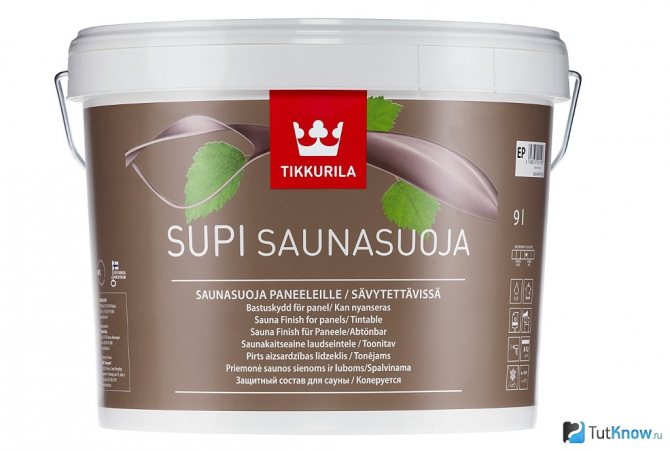
Tikkurila is a generally recognized leader among manufacturers of paint and varnish products, whose product range also includes antiseptic impregnations for wood. Let's take a closer look at the composition of this Finnish company, intended purely for use in baths and saunas - TIKKURILA SUPI SAUNASUOJA:
- View
. Water-soluble acrylate-based protective composition, tinted or colorless, with a semi-matte sheen, safe. - Purpose
. Protects wood, wood fiber and concrete surfaces from mold and blue stains by forming a water- and dirt-repellent film on the surface. - Application area
. Walls and ceilings in the steam room, washroom, locker room. Tikkurila bath antiseptic is not recommended for use on shelves. - Method of application
. Apply with a brush or spray to a dry, clean, polished surface at a temperature not exceeding +5 degrees and humidity not less than 80%. In the steam room, you can apply the composition in one layer without dilution or in two, diluting the tinted composition by half with water. In the locker room and washroom, the antiseptic is applied in two layers, and in the case of a tinted product, the first layer must be diluted to 20%. The interval between applying the first and second layers of sauna antiseptic is 2-3 hours. - Color selection
. First, start with a test paint job to see the approximate result. To do this, select a separate small board. Secondly, keep in mind that diluting the antiseptic with water will make its color less saturated and lighter. Thirdly, to ensure uniform coloring of surfaces, try to process them continuously, being sure to mix the composition. Let us immediately make a reservation that the result of impregnation will depend not only on the color of the composition, but also on the material, that is, the type of wood, as well as its condition, including the presence of treatments already carried out. - Consumption
_ This figure reaches 8-12 m2/l. - Storage
. In tightly closed “native” containers only at above-zero temperatures (from 5 to 30 degrees), since this antiseptic does not tolerate cold weather. - Price
. The cost of antiseptic is from 389 rubles. for 0.9 liters of product.
After treatment, you can steam in a sauna or steam bath within 48 hours.
Let's sum it up
In our article we tried to talk about how to treat a bathhouse inside and outside? The best chemistry , with what means you can treat the bathhouse from the outside and inside. You also learned about the differences between chemical preparations and in what cases they are best used. Precautionary measures were not left unattended.
Based on all of the above, only one conclusion can be drawn: treating the internal and external surfaces of the bathhouse should become a mandatory procedure. If you disinfect wood from time to time, its service life will increase. If you have any questions and did not find answers in the article, you can contact our managers for clarification by calling them at the phone numbers listed in the site contacts.
But we can say unequivocally: treatment is required if you wish health to your family and friends. After all, in a disinfected bathhouse the air is clean, healthy, and helps make the immune system even stronger. It is precisely for this reason that hygiene procedures in the bathhouse must be carried out regularly.
Wood primer
Before the main impregnation of the material, it is primed with a special solution. The most popular primer for planed and sawn wood is Aquatex . It is used for the purpose of antiseptic treatment and increasing the service life of the finish. The primer layer increases adhesion and reduces the consumption of the finishing coating. Impregnation penetrates into the wood structure up to 5 mm, thereby providing protection against rot, fungus, mold and insects.
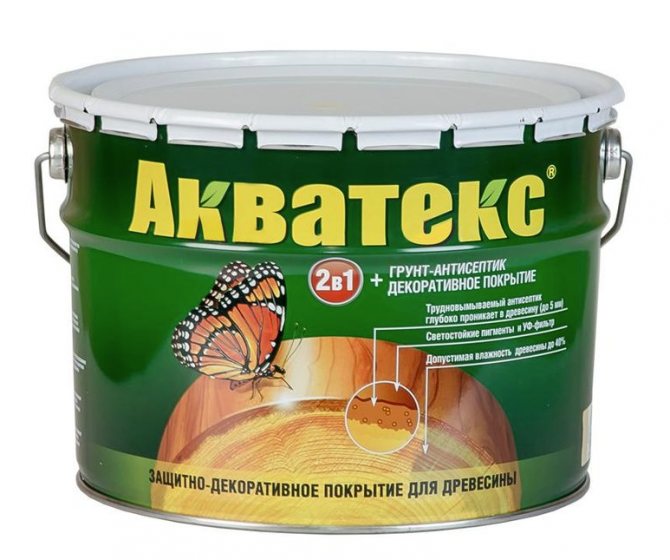
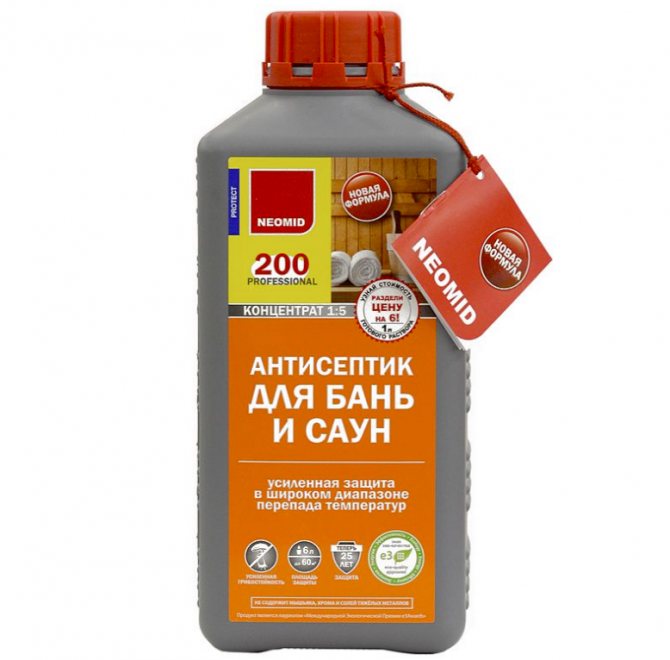
Where to go to purchase drugs for treatment and how to place an order?
The GoodHim company can be called a leader among enterprises engaged in the production of products for the chemical treatment of external and internal surfaces of wooden buildings and wood products. All products have an acceptable price, which is not affordable even for Russians with average incomes. Any antiseptic, impregnation, bleaching compounds that protect against fire and biological pests can be ordered while sitting in your apartment from our website, using online services.
Both individuals and legal entities can order products. In addition, the corporation has a new manufacturing facility called contract manufacturing. Under this service, you can apply for production by submitting your recipes. Then the released product will have your brand.
If you are interested in our products and new service, you can find out more on the website. Find information in the section on “Contract Manufacturing”
Compositions for walls and ceilings
Neomid Sauna is a semi-matte acrylic-based varnish designed for finishing wood. Suitable for processing only clean, dry, undamaged wood. If the finish is restored, it must be treated with bleach and an antiseptic, and then varnish must be applied.
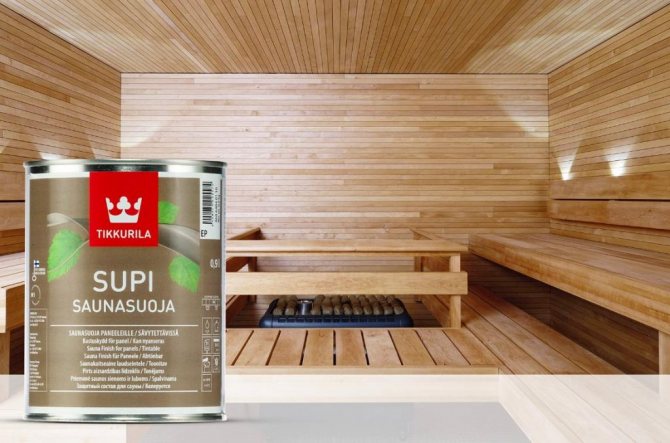
Supi Saunasuoja, Tikkurila - a protective composition created for treating wooden surfaces and preventing rot, mildew and mold. The resulting film creates properties that repel water and dirt.
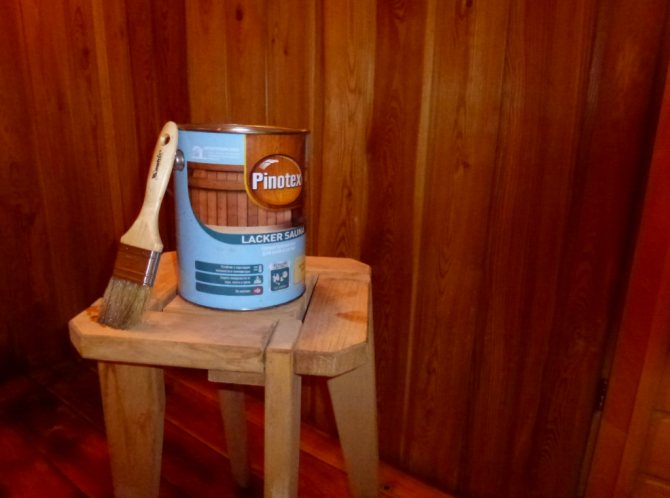
Pinotex Lacker Sauna is a varnish for rooms with moderate and high humidity.
Withstands temperatures up to 120 degrees without changing parameters due to changes. The impregnation layer dries in just 2 hours. Eurotex Sauna is a colorless coating containing wax. Excellently repels water even with prolonged exposure and high temperatures and protects against pathogenic microorganisms. Apply varnish in an average of 2-3 layers.
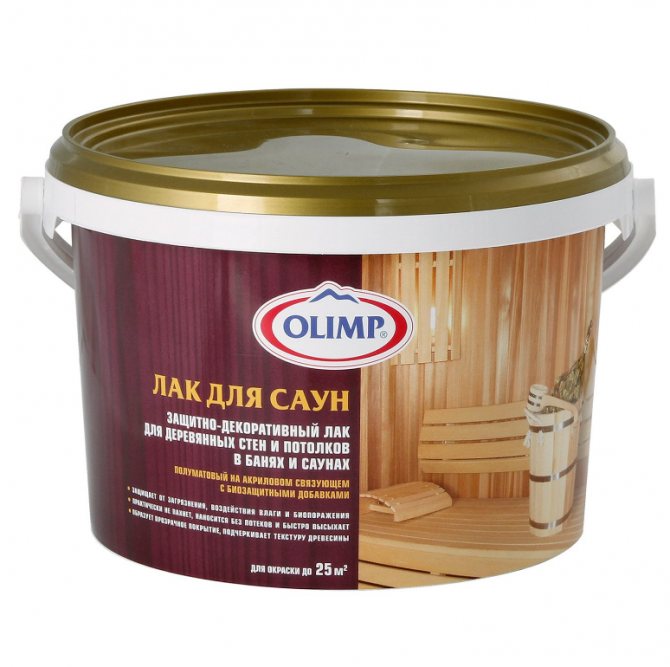
Profiwood Empils is a special line of materials for wood processing that has properties of protection against microorganisms and fire. The use of impregnation will increase the life of the wood and protect it from moisture.

